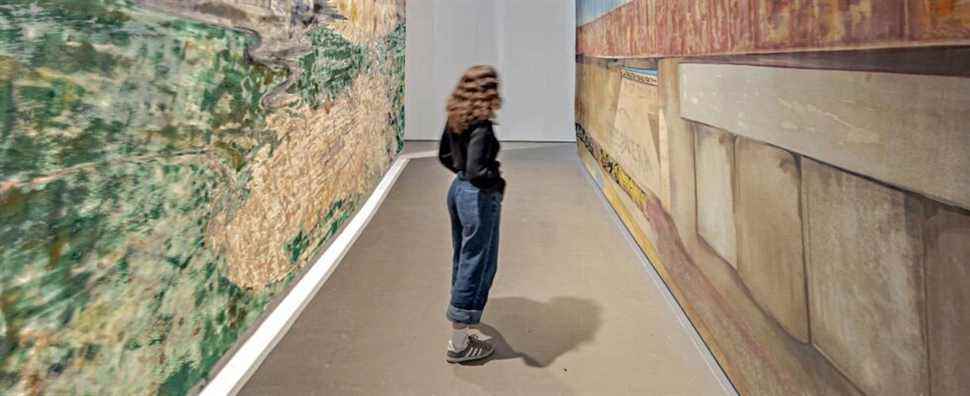Laws are an extension of weapons. British artist Lawrence Abu Hamdan is convinced of this. He demonstrates this in a film installation shot inside the Haskell Library and Opera House — a building straddling Quebec and Vermont. The work that explores the fluctuating and violent nature of the notion of border is the piece de resistance of the Toronto Biennial of Art (TBA), the second edition of which kicked off on the last Saturday of March.
With 45th Parallel, a 15-minute video to watch behind two trompe-l’oeil painted curtains, Lawrence Abu Hamdan brings together real and recent events involving weapons, borders and situations resembling a game of cat and mouse. “All borders are violent,” says the artist, visiting Toronto for a second straight biennale. Borders have always been a lethal instrument. »
In this work co-produced by the Toronto event and presented at the Mercer Union artist-run centre, the most disturbing story concerns the case of a Mexican teenager who was shot and killed in 2010 in the culvert where he was playing. His attacker, a border agent, was exonerated in 2019 on the basis of a strange argument: placed in the United States at the time of the shooting, he cannot be held responsible for a death which occurred on the other side of the border .
“Laws are made to protect shooters. The law is an extension of the gun,” says the Dubai-based artist. The comment, without appeal, is assumed by the one who won the Turner Prize in 2019, the most prestigious in the United Kingdom. more subtle, 45th Parallel takes the form of a monologue during which the narrator circulates in the Haskell library and opera house. Between documentary and staging, the work starts from a very local story – the toilet in the library being used for arms trafficking – to deal with universal themes.
Identity Toronto
“The Venice Biennale is magical, but it’s a great exhibition that you could see anywhere. It is not linked to Venice. Here, our founding documents explore the specificity of Toronto and its region”, comments Ilana Shamoon, director of programming at the TBA and author of the master plan written before the inaugural edition.
A key element defended by the Torontonian, who learned French in Europe, where she lived for 18 years, is to bet on continuity. This is why that the 2019 team of curators (Candice Hopkins, Katie Lawson, Tairone Bastien) returned to service this year, driven by the same thoughts. “They work on the idea of kinship, whether it’s blood, social or between living and non-living beings,” summarizes Ms.me Shamoon.
Like the title of 2019 (“the dilemma of the coast”), the theme of 2022, What Water Knows, The Land Remembers (“what the water knows, the earth remembers”) points to the importance of waterways in Toronto, including those that are buried or dried up. The head of performances, readings and educational programs points to the railway tracks behind 72 Perth Avenue, the building that serves as the event’s headquarters: “the rail covers a river”.
The 2and biennial spans five areas of the city and even beyond — at the Small Arms Inspection Building in Mississauga. It should be noted that seven of the nine places to visit are recycled buildings. 72 Perth Avenue was a church, the museum of contemporary art, a massive industrial building, Mercer Union, a cinema…
Very local, strongly Canadian, the TBA and its “72 days of free art” nevertheless include a strong line-up of foreign artists, such as the famous Judy Chicago – the octogenarian American will close the biennale with a pyrotechnic performance -, the Japanese Aki Onda or Lawrence Abu Hamdan.
“Lawrence did a performance in 2019. We started a dialogue with him that culminated in this year’s work. It wouldn’t exist if the curators weren’t the same”, is convinced Ilana Shamoon.
The TBA, she notes, is listening to First Nations artists. One of them, Ange Loft, Mohawk from Kahnawake, researched the Aboriginal roots of the Ontario capital. His document Toronto Indigenous Context Brief is one of the founding elements of the young biennale. A source of inspiration, says Ilana Shamoon.
behind the poetic What Water Knows, The Land Remembers, there is the idea that a multitude of stories are to be discovered, that a whole series of ecosystems is to be dissected. Heterogeneous works, fragmented, even colored by an excessive baroque, dominate.
The absurdity of a ribbon
For Lawrence Abu Hamdan, the biennial as much as its installation speak “of the arbitrary nature of the possession of land, of violence, but also of the forms of resistance necessary to supplant the political structures which legislate”. Lui approaches the absurdity which makes that a simple line inside a library serves as a demarcation between two countries.
“It’s a real line, a real border, which is ridiculous because it’s a piece of adhesive tape,” he says, still amazed three years after discovering it.
Each border has its story, but they are all connected, believes the artist. The absurdity of the tape on the ground gave him the idea of evoking the variable tightness of other borders that allows a bullet, or a machine, to travel and kill beyond them. This is what led to the death of the Mexican teenager or that, in the summer of 2019, of ten innocent Afghans, targets of a drone pilot sitting in the United States. Lawrence Abu Hamdan is nevertheless driven by the hope that “a single bullet will reveal 1,000 more cases, 40,000 lives [fauchées sans raison] “, and that it can be a factor of change.
Art has the ability to “reformulate an event”, he believes, to place it in a vast network and to build a fairer world, based on new readings. The Toronto Biennale, like this 45th Parallelfully plays this role.
Our journalist was in Toronto at the invitation of the TBA.
Three TBA Highlights
